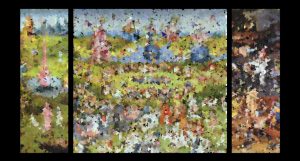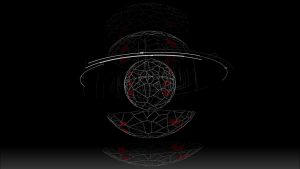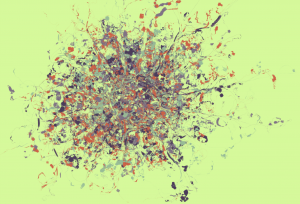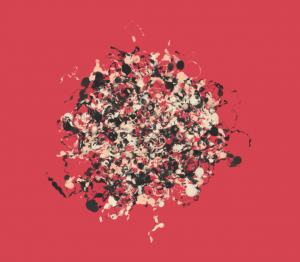Since 2016, Joseph Pollock has been creating procedurally generated artwork using his own program written in C++ and OpenGL. Each image is actually a captured frame of these programs, which continuously animate – from there he does a small amount of manual photo-editing and stitching to create the final image. What’s really fascinating about this is that most of the compositions are solely up to the random nature of the program, making every image unique and engaging. Granted, what we’re seeing is Pollack’s curation of what his program produces, but that doesn’t make the final result any less impressive. I am curious, however, to see more of Pollack’s process and the animations from which he gets his stills. Even as still images, they have a living quality to them – growth and decay all at once.
Month: October 2017
sntong-Looking-Outwards-06-Randomness

This image is by Catodo, which is the stage name of Enrico Zimuel who is a computational artist, sound designer and software developer from Turin (Italy). This particular work he analyzed the painting “The Garden of Earthly Delights” by Hieronymus Bosch, and using the “pointillism” technique, a pixel is selected at random and draws a triangle with random width to the color that corresponds to the original painting. Catodo proposes an interesting interpretation of classical arts and how we can start to read and understand the connection between computational art and classical arts.
ikrsek-Looking Outwards-06
Randomness
The piece that I am choosing to write about for this week’s looking outwards is one which adheres to a more visual randomness, than randomness in regards to intention. The artist of this work is Casey Reas, and this work is an amalgamation of video, photography, and computation which results in seemingly randomized but stunning visual dissonance. Specifically his work in his semi-recent show of about a year, ULTRACONCENTRATED, seems to revel in visuals like these. The pieces however, are not just skin deep – they are meant to be representations of the body through media – each small rectangle a screen snatched from terrestrial television broadcasts. Reas created custom software to pickup on and distort/visualize the signals that flow through the air, and inherently through our bodies – signals which we use to communicate, share, and in doing so plays with our perception of technology and mass media.


NatalieKS-LookingOutwards-06
John Cage, famous for his “indeterminate” approach to music and art, composed an aleatoric piece called “Music of Changes.” Aleatoric music is music in which at least some element is randomly generated or somehow left to chance. This particular composition, composed in 1951, is a 43 minute piano solo, employing not only the keys but also the strings, pedals, and lid of the piano itself. He had based his composition off of a Chinese oracle book called I Ching (or Book of Changes). Using the chance-based operators listed in I Ching, Cage computed charts to use for various aspects of his piece – tempo, notes, rhythm, etc. – so that the piece would be entirely random. As with a large body of his work, Cage wanted to explore the “ability of a piece to be performed in substantially different ways.”
I really admire this piece for its exploration of patterns and how it embraced complete randomness. Music is heavily based on patterns – repeating choruses and motifs, among others – and we consider “good” music to have such patterns. This piece in contrast seems very disconnected and disorienting, and challenges those notions of “good” music. It is thought-provoking and interesting, if hard to listen to.
rmanagad-lookingoutwards-06-sectione
Creator: Felix Turner
Title of Work: Noise Field
Year of Creation: 2011
Link to Project Work: https://airtightinteractive.com/demos/processing_js/noisefield08.html
Link to Artist Bio: https://www.airtightinteractive.com/about/
 Noise Field is an interactive, mouse-based random activity program running on p5.js. As a function, Noise Field uses Perlin Noise — a gradient-based procedural algorithm that increases the believability of computer-generated animations –and noise parameters based on mouse movement and placement to generate colored ellipses from central points. With that being said, randomness is present as clicking produces a random set of parameters for the movement of the ellipses.
Noise Field is an interactive, mouse-based random activity program running on p5.js. As a function, Noise Field uses Perlin Noise — a gradient-based procedural algorithm that increases the believability of computer-generated animations –and noise parameters based on mouse movement and placement to generate colored ellipses from central points. With that being said, randomness is present as clicking produces a random set of parameters for the movement of the ellipses.
This work is influential in expanding my mindset towards the possibilities of using p5.js as a communicative medium — I’d like to eventually be able to apply Processing towards the creation of interactive web-based programs that use natural elements.
Bettina-LookingOutwards-06-SectionC

Generative poster wall display, an installation created by Dutch design company Lust Design.
This installation generates hundreds of unique posters from various internet sources, and new posters are generated when a new visitor enters/interacts with the space. In this way, the project is random not necessarily because the code itself calls random variables (i.e. when we set a value to random()) but because the conditions under which items are generated on random: one cannot predict when and how people will interact with the exhibit or what content will be available online at that time. Surely, there are still set constraints, but the dependence on audience interaction makes this piece feel as if viewers take part in creating the art. I admire how the system needs to have a level of ambiguity to adapt to visitor interactions– that concept is reminiscent of how designers are taught to be comfortable with ambiguity as well. According to the studio’s site, the piece was implemented using a series of kinects. I’d be interested in learning to code with hardware, such as arduino or raspberry pi. My impression is that using such components allows one to create more spatial and interactive pieces instead of experiences on a laptop screen.
Ziningy1-Section C – Looking outward 06


SoN01R is a realtime dynamic artistic visualisation and sonification of the quantum vacuum, more specific quantum fluctuations. The project was lead byDr. Thomas Seymul, using a realtime data feed from the Australian National University, Department of Quantum Science. By tapping into a physical quantum source they can generate true random numbers in realtime which drive the audiovisual work. I was very interested by how the project utilized the source of quantum to generate random visualizations and audio. So, in physics, quantum is the minimum amount of any physical entity involved in an interaction. After having some basic knowledge on the quantum, I become more impressive for the project as How can one visualize something immaterial, short lived and universal as quantum fluctuations? I could not find information on how exactly they monitors the quantum fluctuations, which is basically the temporary appearance of energetic particles out of nothing. The thought behind this project by linking the smallest particle in physics world to an artistic representation is truly inspiring. And they accomplished the conversion in a very aesthetically pleasing way.
sijings-lookingOutwards-06
http://color-wander.surge.sh
video cannot be embedded here and thus a link is provided.

My ideas for the use of randomness in the computation of art is about randomized patterns that a function computes. “Generative Art with Node.js and Canvas” is one of the randomized artwork I appreciated. This is not a famous art piece but a small weekend project that combines Node.js and HTML5 Canvas to create high-resolution generative artwork. The reason I chose this instead of other big names works is because of the amazing color combination and the shape of each growing elements. Visually, this appears to me as a really interesting and aesthetic artwork. In the artist’s blog, he detailedly records of his process. He chose to use Node.js, pursuing a fast speed and a high resolution of the pattern.



In each version, the particle is rendered as a small pattern with direction and velocity. The scale and the mass’ scale is randomized to reach some straight and curly lines. After this, he uses photographs as “distortion maps” to drive the algorithm so some of his work looks as random segments creating some larger scale pattern. Lastly, he randomized the color from the “color lovers API”. He also uses many randomizations including the choice of color, the scale of particles, and the mass’ scale. Thus, I think this uses a “truly” random method for accomplishing the final results. Overall, I enjoyed the visual pattern and the pattern each particle accomplished.
![[OLD FALL 2017] 15-104 • Introduction to Computing for Creative Practice](../../../../wp-content/uploads/2020/08/stop-banner.png)



